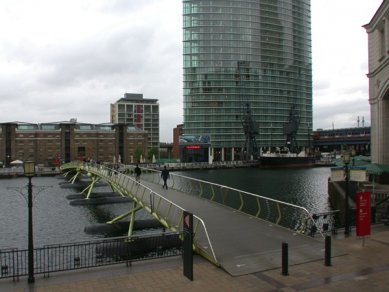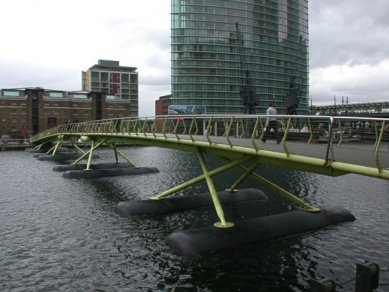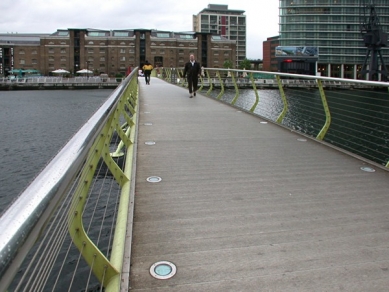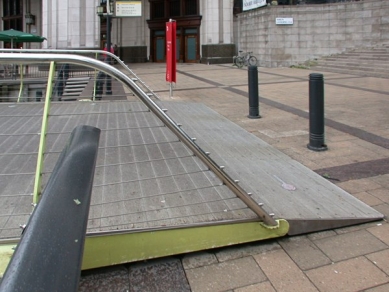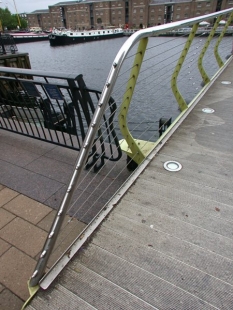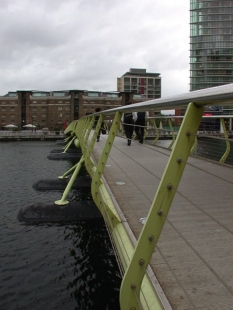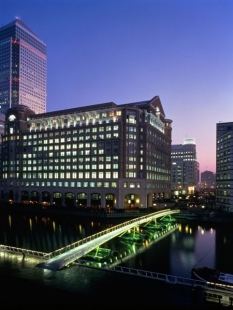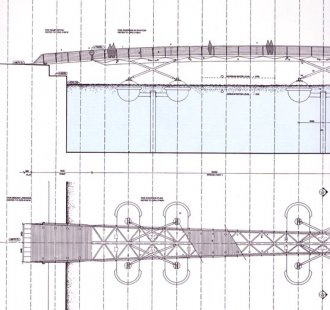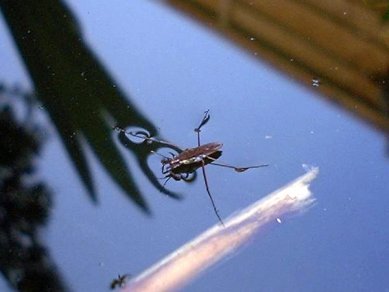
Most for pedestrians West India Quay

The fantastic floating pedestrian bridge in London's Docklands was completed just two years after Hauer-King House (the first major realization by FS) and immediately attracted a lot of attention. With this bridge, Future Systems also demonstrated their ability to truly realize their progressive projects.
The design won a competition announced by the London Docklands Development Corporation. It spans 94 meters wide West India Quay between the newly emerging Canary Wharf and the old 19th-century warehouses on the other bank. Its inspirations were the old arch bridges, suspended cable bridges, and floating pontoon bridges. However, for the architects at Future Systems, a much broader field of inspirations is characteristic, and therefore the most significant inspiration was found in the brightly colored water insect (Water Skater).
Prefabrication has always played a significant role in the work of Future Systems. As the architects of pre-war modernity proclaimed, construction parts should be created more in a dry and efficient work environment using precise industrial equipment, rather than on a weather-beaten construction site. The subsequent smooth transport of both halves of the bridge, escorted by police from the factory to Kaplický's dock, further solidified his views on prefabrication.
The bridge consists of a lightweight steel structure with an aluminum walking surface. The entire structure rests on four pairs of foam-filled pontoons with a diameter of 2800 mm, which are anchored to concrete piles. Both ends of the bridge are lower than its center, which can be hydraulically opened to allow passing ships to sail freely. Night lighting was one of the main themes of the concept. Lighting units were integrated into the railings, which are additionally complemented by emergency walkway lights directly in the deck, creating an elegant line that disappears into the distance. The bridge today practically serves its purpose while also providing excitement - when the floating structure gently sways beneath you as you walk.
The design won a competition announced by the London Docklands Development Corporation. It spans 94 meters wide West India Quay between the newly emerging Canary Wharf and the old 19th-century warehouses on the other bank. Its inspirations were the old arch bridges, suspended cable bridges, and floating pontoon bridges. However, for the architects at Future Systems, a much broader field of inspirations is characteristic, and therefore the most significant inspiration was found in the brightly colored water insect (Water Skater).
Prefabrication has always played a significant role in the work of Future Systems. As the architects of pre-war modernity proclaimed, construction parts should be created more in a dry and efficient work environment using precise industrial equipment, rather than on a weather-beaten construction site. The subsequent smooth transport of both halves of the bridge, escorted by police from the factory to Kaplický's dock, further solidified his views on prefabrication.
The bridge consists of a lightweight steel structure with an aluminum walking surface. The entire structure rests on four pairs of foam-filled pontoons with a diameter of 2800 mm, which are anchored to concrete piles. Both ends of the bridge are lower than its center, which can be hydraulically opened to allow passing ships to sail freely. Night lighting was one of the main themes of the concept. Lighting units were integrated into the railings, which are additionally complemented by emergency walkway lights directly in the deck, creating an elegant line that disappears into the distance. The bridge today practically serves its purpose while also providing excitement - when the floating structure gently sways beneath you as you walk.
The English translation is powered by AI tool. Switch to Czech to view the original text source.
12 comments
add comment
Subject
Author
Date
Pane Šmídek, můžete prosím objasnit
Já
21.01.09 12:34
pro Já
Petr Šmídek
21.01.09 09:40
Ad Petr Šmídek
21.01.09 09:34
pro pana Šmídka
My
21.01.09 10:58
pro _
Petr Šmídek
21.01.09 01:33
show all comments


